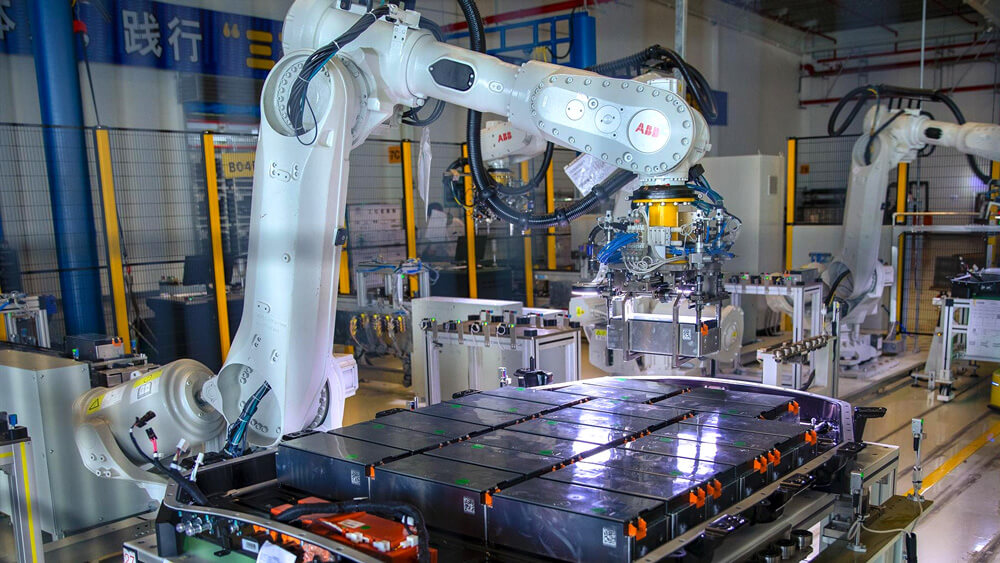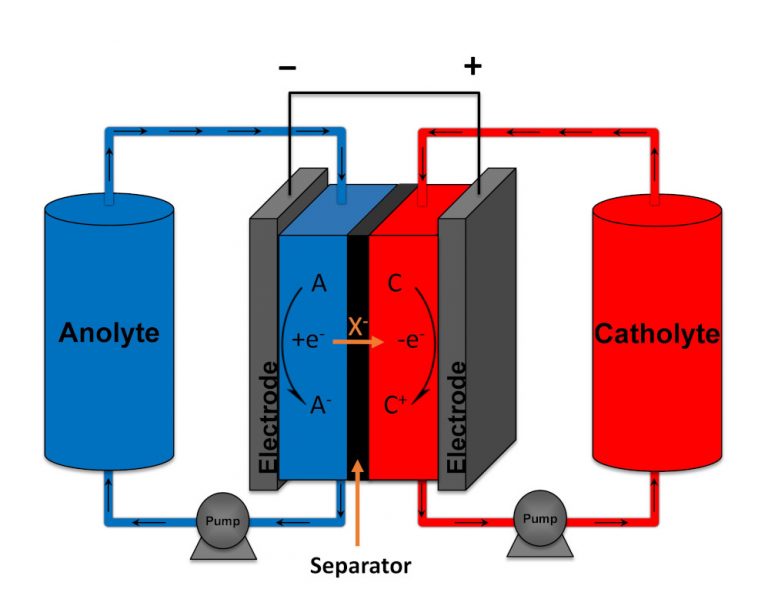The growing shift to clean energy propels the global expansion of renewable energy installations. Meeting the ever-increasing energy demand and facilitating large-scale transition necessitates the crucial role of energy storage. Likewise, addressing the intermittent nature of renewable energy sources demands incorporating low-cost and durable energy storage systems into electric grids.
Thermal energy storage, organic flow batteries, lithium-ion, sodium-sulphur, compressed air energy storage, and pumped hydro storage actively serve as viable options for large-scale storage, ranging from tens to hundreds of megawatt-hours.

Source: Tycorun Energy.
First, the flow battery is an electrochemical energy storage considered a promising technology for large-scale renewable energy conversion and storage, due to its inherent decoupling of power output and energy storage capacity. Among the diverse types of flow batteries, the organic flow battery, utilising naturally abundant organic molecules as its redox-active species, is actively recognised as a suitable choice for achieving high performance, enhanced energy density, and reduced costs.
What Are Organic Flow Batteries?
Put simply, Organic Flow Batteries (OFBs) are energy storage technology that uses organic compounds (carbon-based molecules) to store and release electrical energy. These batteries work by flowing liquid organic molecules through a system, where they undergo chemical reactions to store or release energy.

Organic flow batteries leverage the abundance, excellent structural tunability, and low cost of organic molecules as Redox-Active Materials (RAMs), to achieve high designability for low-cost and high-energy-density flow batteries. Depending on the electrolyte media, OFBs are categorised into Aqueous Organic Flow Batteries (AOFBs) and Non-Aqueous Organic Flow batteries (NAOFBs). The latter offers a wide range of working temperatures, high cell voltage, and potential energy density.
Benefits of Organic Flow Batteries
Organic flow batteries present several advantages over conventional flow batteries which include:
Low toxicity and flammability
OFBs are unique due to electrolytes that are less hazardous and less prone to combustion. Conventional flow batteries often employ hazardous substances like vanadium, zinc, or bromine requiring special handling and disposal. Alternately, OFBs utilise organic molecules such as quinones, ferrocenes, or viologens. These organic compounds are obtained from natural sources or synthesised from abundant materials.
High energy density and scalability
Another benefit of OFBs is that they have higher energy density and scalability than conventional flow batteries. OFBs have higher energy density because organic molecules can store more electrons per molecule than metal ions. OFBs also have higher scalability because they can use different organic molecules for the positive and negative electrolytes, which allows for more flexibility and optimisation of the system performance.
Low cost and environmental impact
OFBs have lower costs because organic molecules are cheaper and more abundant than metal-based or inorganic compounds. OFBs also have a lower environmental impact because they use less energy and water for production and operation. Also, they generate less waste and emissions.

Source: M2N Research Group.
moving forward
Renewable energy sources such as solar and wind power are increasingly replacing fossil fuels. Organic flow batteries display significant potential for widespread integration of large-scale energy storage.
Organic Flow Batteries are suitable for different application areas in the power grid such as the intermediate storage of power from renewable energy generation or in connection with the balancing of demand peaks in industrial companies. Additionally, OFBs can be utilized in the charging infrastructure required for electric mobility. The batteries enable a buffer storage to relieve power grids which do not have to be upgraded for additional loads. Although OFBs are in the early stages of research and development, their potential as a viable and sustainable solution for future energy storage is considerable.
Why is it essential that we focus on Organic Flow Batteries?
Using ‘organic’ electrolytes makes redox flow batteries a more efficient, long-lasting, and sustainable electricity storage technology. Unlike lead-ion, lithium-ion, and other traditional redox flow batteries based on vanadium- and zinc-based battery chemistries, OFBs are unique alternatives due to the easy replaceability of the liquid electrolyte.
While OFBs offer numerous benefits, challenges such as organic molecules’ stability, solubility, and selectivity impact the system’s efficiency, durability, and reliability. Opportunities for OFBs include the exploration of new organic molecules, the improvement of system design and integration, and the identification of new applications and markets.
achieving the United Nations Sustainable Development Goals (SDGs) and how they link to Organic Flow Batteries
The renewable energy transition needs powerful, scalable, and affordable energy storage systems that do not harm people and nature. Advancements in battery technology are essential to meet climate goals sooner, especially in contributing to achieving SDG9 and SDG7. SDG9 supports the development of sustainable infrastructure, promoting innovation, facilitating sustainable industrialisation, and enabling the transition to cleaner and more efficient energy systems. Moreover, SDG7 aims to ensure access to affordable, reliable, sustainable, and modern energy for all. Achieving this goal is vital to protect our environment, foster economic growth, reduce poverty, and improve quality of life.
A Thrivable Framework
At THRIVE, we firmly embrace the infinite potential of humanity. Our mission is to ignite the awareness of implementing sustainable solutions. By not only preventing catastrophe and nurturing societies to flourish, we unlock their true potential for prosperity and growth. Our THRIVE Framework examines issues and evaluates potential solutions concerning this overarching goal of thrivability. It is about making predictive analyses using modern technology that supports environmental and social sustainability transformations.
The transition to carbon neutrality and renewability is well underway—and batteries have a significant role. To learn more about how the THRIVE Project is researching, educating, and advocating for a future beyond sustainability, visit our website. THRIVE has its own set of publications as a guide for anyone wanting to run or support sustainable business practices. You can follow our informative, diverse blog and podcast series, and learn more about our regular live webinars. Sign up for our newsletter to receive regular updates.
